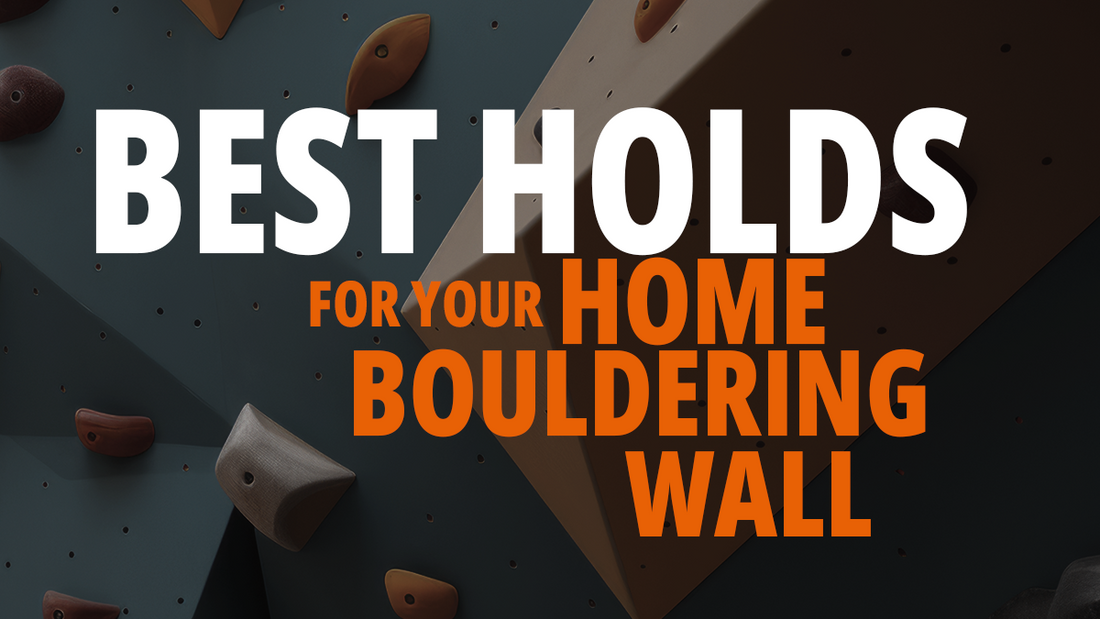
Best Holds for Your Home Bouldering Wall
Share
A home bouldering wall is only as good as the holds you put on it. The right holds can determine how hard your wall is, help develop technique, and keep training sessions engaging. Whether you’re a beginner looking for comfortable holds or an experienced climber looking to increase your fitness, selecting the right holds can make all the difference in your progression.
Not All Holds Are Created Equal
Factors like shape, texture, material, and placement influence how you interact with your wall. The angle of your wall, your climbing goals, and even the size of your hands will determine which holds work best for you.
A well-rounded mix of holds is a great starting point for any home wall. It allows for creative route setting and helps increase your strength in various directions. This is a good option if you’re not sure what to get or if you’re a newer climber who can benefit from continuous climbing.
However, a more experienced climber may want to target a specific area of their training, such as climbing on crimps or pinches. Consider this when choosing holds for your home wall.
What Are Your Hold Options?
In their diverse forms, climbing holds are versatile tools that define your training regimen. Each hold type offers a unique challenge, from big, friendly jugs to tiny credit-card crimps, allowing you to craft a training plan that suits your climbing goals and style.
Jugs
Jugs are large holds with a comfortable grip, perfect for warm-ups, endurance training, and beginner-friendly routes. They are the backbone of any climber’s experience. A few well-placed jugs can help if you want solid rest points on your wall.
Crimps
Crimps are small, edge-like holds that require precise finger placement. They help develop finger tendon strength and overall grip endurance. Crimp training should only be done after you’ve been climbing for a while. If you are just starting out, using them in moderation is key to building strong fingers and preventing overdoing it.
Slopers
Slopers require friction and full-hand contact rather than finger strength. These rounded blobs improve open-hand grip strength and force you to engage your entire body to maintain balance. Using slopers on varying wall angles can help climbers develop better body positioning and control.
Pinches
Pinches require you to engage your thumb, strengthening your entire hand. They come in all sizes, from narrow to wide, and demand firm grip and forearm endurance. They’re handy for climbers who want to work on their compression skills.
Pockets
Pockets range from two-finger to full-hand depth (unless you count a mono as a pocket) and are great for finger strength and precision. Pockets add a technical element to your wall, requiring accurate finger placement.
What Hold Materials Work Best?
Polyurethane vs. Polyester
Polyurethane holds are lightweight, durable, and less prone to chipping, making them popular for home walls. Polyester holds, while heavier and more rigid, offer a more traditional texture and better friction.
Textured vs. Smooth: How Surface Affects Grip
Holds with a rougher texture provide better grip but can be harsh on the skin, especially during long sessions. Smoother holds, while gentler, may require more grip strength to stay on.
Mixing Hold Types for Variety and Progression
A diverse selection of holds keeps training dynamic and prevents boredom. Combining different grip styles helps target various muscle groups and climbing techniques so you can switch it up throughout your session.
Hold Sets for Beginners, Intermediate, and Advanced Climbers
Beginners benefit from jugs, large pinches, and moderate edges. Intermediate climbers should incorporate crimps, slopers, and smaller pockets. Advanced climbers can challenge themselves with tiny crimps, sloping pinches, and generally anything they want.
Setting Problems with Different Climbing Styles
A well-designed home wall is more than just a training ground. It's a preparation for the real thing. By setting problems that mimic outdoor climbing styles, you can enhance your real-world climbing performance and feel more confident on the rocks.
Where to Buy the Best Bouldering Holds
Companies like Moon Climbing, Metolius, and Kilter produce high-quality holds known for their durability and innovative designs. Investing in reputable brands ensures long-lasting performance.
Budget-conscious climbers can find affordable hold sets from brands like Atomik and Escape Climbing. Buying second-hand holds or bundle deals also helps keep costs low.
For those who want a personalized touch, making DIY wooden holds or ordering custom-designed holds from specialized manufacturers can give you a unique climbing experience.
